
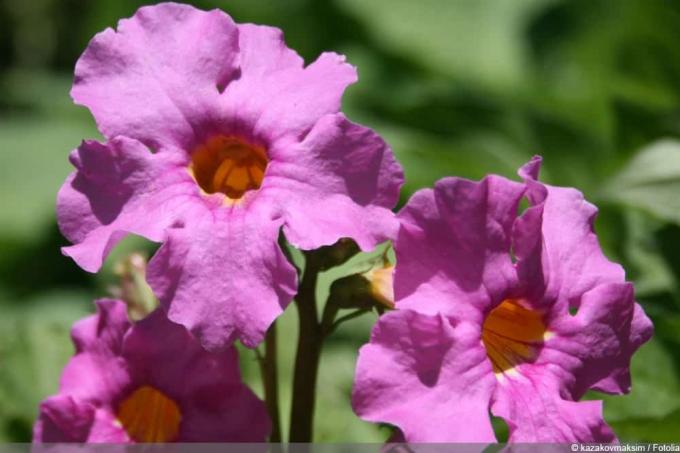
Table of contents
- species and occurrence
- Location
- Floor
- Plant
- advancing the tubers
- Flowering fern as a tub culture
- Pour
- Fertilize
- Cut
- propagation by division
- Propagation by seeds
- Hibernation outdoors
- Hibernation in winter quarters
- diseases and pests
Green fern leaves and colorful trumpet blossoms? The garden gloxinia can actually do both. Therefore, it is also commonly referred to as a blooming fern. But the plant is not at all related to the real fern. Doesn't matter. With this impressive combination of leaves and flowers, the name and lineage are secondary anyway. The more important question is: with what care do you get this fake fern to bloom?
species and occurrence
The outdoor gloxinia family includes 14 different species. These trumpet plants usually come from Asian high-altitude regions. The predominant number belongs to the tropical trees. The herbaceous At Incarvillea delavayi also feels at home in temperate zones. We have a few varieties on offer, all of which differ slightly in appearance.
- also known as Chinese trumpet flower
- Perennial grows 40 to 60 cm high
- usually blooms in June and July
- white or pink flowers, yellow throat
- 'Deli Rose' has pink flowers and is ideal for a rock garden
- "Alba" bears white flowers
- Incarvillea olgae grows taller
- other varieties: Incarvillea mairei, Incarvillea grandiflora and others
A notice:
Houseplants cultivated under the name gloxinia belong to a completely different genus.
Location
Outdoor Gloxinia are flexible plants. Its tubers feel at home both in tubs and in the garden soil. All that matters is that they always get enough light, moisture and a handful of nutrients.
- sunny and partially shaded locations provide sufficient light
- Perennial beds and rock gardens suitable
- in neighborhood with cushion asters, larkspur and larkspur
- in pots on the terrace and balcony
Floor
Light, humus-rich soil is well suited for the flowering fern. The pH should be in the neutral to slightly acidic range. The ideal soil for the gloxinia tubers should also be able to retain moisture, as this plant does not like drought.
- normal garden soil
- or mixture of sand and clay
- pH at around 5-7
- medium nutrient content
Tip:
Some gloxinia species are content with calcareous soil. If you can only offer such a soil, you don't have to do without a flowering fern. Check the store for a suitable variety.
Plant
Newly purchased tubers or plants are allowed to enter their permanent outdoor home from mid-May, when there are no more frosts.
- Loosen the soil well. Remove larger stones and old roots.
- Check the soil quality. Mix in some sand if the soil is too heavy.
- Soil that tends to become waterlogged requires drainage. Use gravel, clay or coarse sand for this.
- Enrich poor soil with potting soil or compost to increase the nutrient content.
- Now dig a planting hole about 5 cm deep for each tuber. The distance between the individual plants should be 20 to 30 cm.
- Plant the tubers and cover them with soil.
- Water the freshly planted gloxinias well.
Tip:
The garden gloxinia does not grow into a huge perennial. As a solitary plant, it can therefore easily go under optically. Only a planting of several tubers gives it the attention it deserves.
advancing the tubers
In the trade, garden gloxinias are usually sold as tubers. They can be planted directly in the garden bed as previously described. The first thing they have to do is drive out. Flowering will have to wait a few more weeks. However, this waiting time can be shortened considerably if the tubers are allowed to sprout in warm rooms from March.
- start with the pre-cultivation from March
- in large pots from 20 cm in diameter
- in a loose floral or Plant garden soil
- Keep soil moist but not too wet
- only water more when the shoots appear
- The ideal temperature is between 18 and 22 degrees Celsius
- Plant out from mid-May
A notice:
The tuber will only sprout if it is planted vertically. The "fingers" must point downwards.
Flowering fern as a tub culture
Chinese trumpet flower can also thrive in a bucket, but then needs more attention:
- use a mixture of soil, sand and humus as a substrate
- Drainage layer made of expanded clay or gravel protects against waterlogging
- water regularly
- give liquid fertilizer over irrigation water every 2-3 weeks
- Cut faded flowers promptly
Pour
The blooming fern likes moist soil, but it doesn't cause waterlogging. Persistent wetness can cause the tubers to rot.
- water regularly during dry periods
- Don't get the leaves wet
- Water only directly in the root area
- Avoid waterlogging at all costs
- in sunny places there is a high risk of evaporation
- Protect the root base from drying out with a layer of mulch
Fertilize
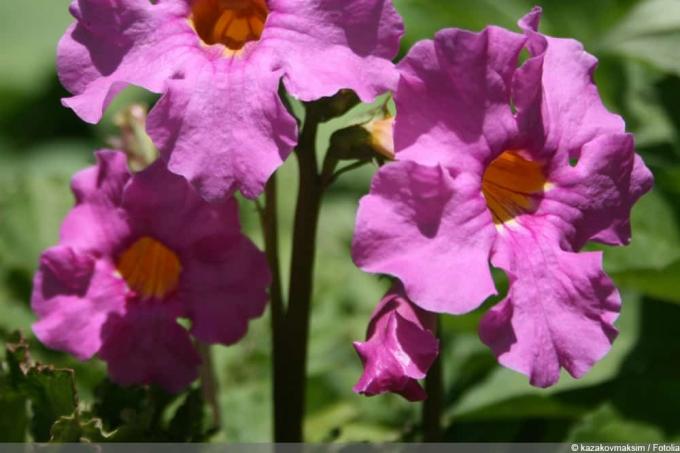
The Incarvillea is a modest nutrient consumer. Their care is gardener-friendly in this respect. It is completely sufficient to replenish the nutrient depot every now and then.
- humus-rich soil forms a good basis
- Composting in the spring provides supplies
- alternatively spread long-term fertilizer
- e.g. B. with horn shavings or blue grain
Cut
Flowering fern does not require pruning. Only withered stems should be removed promptly. The energy that would otherwise be required for seed ripening is available for new flowering. In autumn, the dried-up above-ground parts are cut off close to the ground.
propagation by division
With bulbous plants, the bulbs grow larger and more branched over time, allowing them to be cut into at least two parts. In the case of the garden gloxinia, the mother plant sometimes reacts sensitively to division and can even die off completely. In this case, only the newly gained young plants remain.
- only divide tubers from older gloxinia
- do not cut during the main growing season
- the month of February is more appropriate
- use a sharp, sterile knife
- cut off part of the tuber with a clean cut
- Keep the interface as small as possible
- Plant tuber parts in pots
- Transplant outdoors from mid-May
Tip:
Open interfaces are entry points for germs. Therefore, let the cut tubers dry for several hours. Alternatively, you can sprinkle the cuts with some charcoal powder before planting.
Propagation by seeds
Gloxinia inflorescences develop seeds that are ready for harvest in the fall. After drying, they must be stored until spring, because only then are the conditions for sowing optimal.
- Sow in February or March
- Scatter in pots with moist growing soil
- blooming fern germinates in the light
- Press down lightly, do not cover with soil
- Cover pots with transparent foil (ventilate daily)
- Location: bright, 22-25 degrees, without direct sun
- prick out after germination
- now continue cultivating at 10 to 15 degrees
- From 2-3 papers, foil is no longer necessary
- from May outdoor is allowed
A notice:
The propagation of gloxinias via seeds is inexpensive and effortless, but it is also possible has one disadvantage: the little plants that are created in this way take up to three years before they are able to flower are.
Hibernation outdoors
Outdoor gloxinias are considered hardy and tolerate 20 degrees below zero. However, a warm cover cannot harm them. With particularly severe frosts, their tubers may suffer. It is also important that no waterlogging can form, otherwise the tubers will rot.
- Cut off above-ground plant parts just above the ground
- Cover root base in fall
- with leaves, brushwood, mulch etc. Ä.
Hibernation in winter quarters
In autumn, flowering ferns draw all their strength back into the tubers. The plant is now "compact" and handy. Therefore, overwintering in a suitable winter quarters is also possible. The extra work of digging out and digging in again is offset by the 100% protection against frost.
- In late autumn, carefully dig up the tubers to avoid damaging them.
- Leave the tubers on newspaper in a warm, airy room for a few days. During this time they will dry out, which will protect them from mold and rot.
- Put the tubers in a wooden box with straw.
- Place the wooden box and tubers in a cool, dark place. Cellars, frost-free garages and attics are ideal.
- From February you can advance the tubers. Or you can wait until mid-May and plant them directly in their summer location.
diseases and pests
Luckily, the voles don't like the tubers of the outdoor gloxinia at all. For snails, on the other hand, the whole plant is tempting food. Eaten shoots and bare stems are visible snail alarm. It must be acted quickly, because the slimy creeps have a big appetite.
- Make access difficult for snails
- regular raking prevents wet soil
- collect snails
- Scatter slug pellets
- Send beneficial insects such as threadworms on a snail hunt
Yellow leaves on flowering ferns are rarely the result of pests. The cause is usually too much moisture. Gloxinia like it moist but not too wet. By now, at the latest, the permeability of the soil should be improved. This is very easy to do by working in a generous amount of sand.
 garden editorial
garden editorial I write about everything that interests me in my garden.
Find out more about perennial lexicon

Lenten rose, Helleborus orientalis: 13 tips for care
The spring rose is one of the few plants that also blooms in winter. In order for the plant to bear its colorful flowers, however, certain requirements regarding location and care must be met.
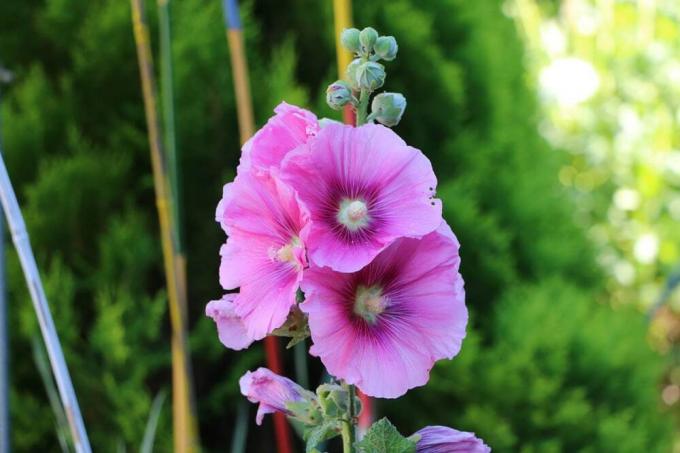
13 hardy perennials for sunny locations
Hardy perennials have a particularly long lifespan and allow sunny locations to bloom beautifully. At the beginning of each season, the perennial plants thrive anew and enchant the garden with a colorful world of flowers. Due to the large number of varieties, you have many design options.

Tree peony, Paeonia suffruticosa: Care from A - Z
With its large, eye-catching and colorful flowers, it is one of the noblest representatives of the peonies, the tree peony. Its natural home is China, which is why it is often referred to as the imperial flower. It presents its beautiful flowers between April and June.

Fat man: Care from A-Z | Planting distance and propagation
The shady areas under trees are neglected in many gardens, because only a few plants feel comfortable here. One of these few plants is the fat man (bot. Pachysander terminalis).
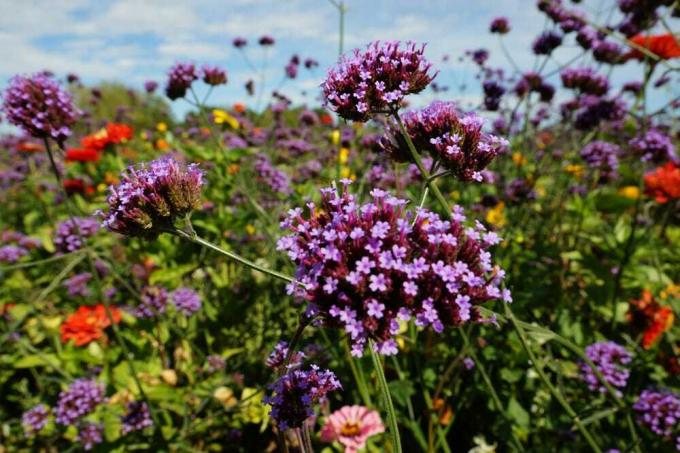
Patagonian Verbena, Verbena Bonariensis - Care Guide
Summer, sun, garden, flowers - here the Patagonian verbena is in its element, with fairy-like lightness purple flowers float on filigree stems above the flower bed and also attract all the butterflies area. Romantic gardeners love the effect of Verbena bonariensis, every gardener loves it Vigorous growth with the lowest maintenance requirements - verbena is a herb that benefits every garden brings.
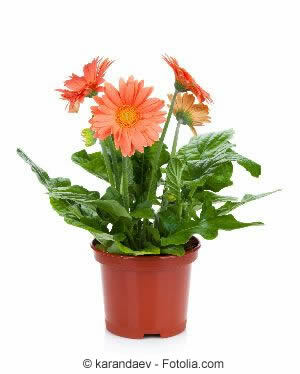
Pot gerbera - instructions for caring for gerberas in pots
The pot gerbera is a lot of fun, but requires a lot of care. It needs to be watered daily and fertilized regularly. A lot of light is a must and yet it must not be exposed to excessive heat. But if you treat her properly, she will thank you with her beautiful flowers.
